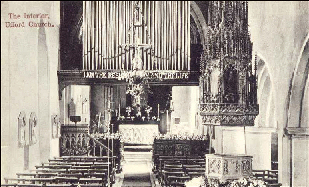| |
|
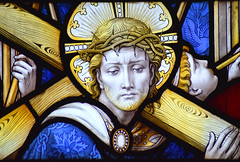 |
|
Upper Ufford is a pleasant
place, and known well enough in Suffolk. Pretty
much an extension northwards of Woodbridge and
Melton, it is a prosperous community, convenient
without being suburban. Ufford Park Hotel is an
enjoyable venue in to attend professional courses
and conferences, and the former St Audrey's
mental hospital grounds across the road are now
picturesque with luxury flats and houses. And I
am told that the Ufford Park golf course is good,
too, for those who like that kind of thing.
But as I say, that Ufford is really just an
extension of Melton. In fact, there is another
Ufford. It is in the valley below, more than a
mile away along narrow lanes and set in deep
countryside beside the Deben, sits Lower Ufford.
To reach it, you follow ways so rarely used that
grass grows up the middle. |
You pass old Melton church,
redundant since the 19th century, but still in use for
occasional exhibitions and performances, and once home to
the seven sacrament font that is now in the plain 19th
century building up in the main village. Eventually, the
lane widens, and you come into the single street of a
pretty, tiny hamlet, the church tower hidden from you by
old cottages and houses.
In one direction, the lane to
Bromeswell takes you past Lower Ufford's delicious little
pub, the White Lion. A stalwart survivor among fast
disappearing English country pubs, the beer still comes
out of barrels and the bar is like a kitchen. I cannot
think that a visit to Ufford should be undertaken without
at least a pint there. And, at the other end of the
street, set back in a close between cottages, sits the
Assumption, its 14th century tower facing the street, a
classic Suffolk moment.
The dedication was once that of hundreds of East Anglian
churches, transformed to 'St Mary' by the Reformation and
centuries of disuse before the 19th century revival, but
revived both here and at Haughley near Stowmarket. In
late medieval times, it coincided with the height of the
harvest, and in those days East Anglia was Our Lady's
Dowry, intensely Catholic, intimately Marian.
The Assumption was almost certainly not the original
dedication of this church. There was a church here for
centuries before the late middle ages, and although there
are no traces of any pre-Conquest building, the apse of
an early-Norman church has been discovered under the
floor of the north side of the chancel. The current
chancel has a late Norman doorway, although it has been
substantially rebuilt since, and in any case the great
glories of Ufford are all 15th century. Perhaps the most
dramatic is the porch, one of Suffolk's best, covered in
flushwork and intriguing carvings.
| Ufford's graveyard is
beautiful; wild and ancient. I wandered around
for a while, spotting the curious blue crucifix
to the east of the church, and reading old
gravestones. One, to an early 19th century
gardener at Ufford Hall, has his gardening
equipment carved at the top. The church is
secretive, hidden on all sides by venerable
trees, difficult to photograph but lovely anyway.
I stopped to look at it from the unfamiliar
north-east; the Victorian schoolroom, now a
vestry, juts out like a small cottage. I walked back around to the south
side, where the gorgeous porch is like a small
palace against the body of the church. I knew the
church would be open, because it is every day.
And then, through the porch, and down into the
north aisle, into the cool, dim, creamy light.
One afternoon in August 1644 Ufford had a famous
visitor, a man who entered the church in exactly
the same way, a man who recorded the events of
that day in his journal. There were several
differences between his visit and the one that I
was making, and one of them was crucial. He found
the church locked. He was the Commissioner to the
Earl of Manchester for the Imposition in the
Eastern Association of the Parliamentary
Ordinance for the Demolishing of Monuments of
Idolatry, and his name was William Dowsing.
|
|
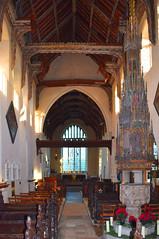 |
Dowsing was a kind of 17th century
political commissar, travelling the eastern counties and
enforcing government legislation. He was checking that
local officials had carried out what they were meant to
do, and that they believed in what they were doing. In
effect, he was getting them to work and think in the new
ways that the central government required. It wasn't
really a witch hunt, although God knows such things did
exist in abundance at that time. It was more as if an arm
of the state extended and worked its fingers into even
the tiniest and most remote parishes. Anyone working in
the public sector in Britain in the early years of the
21st century will have come across people like Dowsing.
As a part of his job, Dowsing was an iconoclast, charged
with ensuring that idolatrous images were excised from
the churches of the region. He is a man blamed for a lot.
In fact, virtually all the medieval imagery in English
churches had been destroyed by the Anglican reformers
almost a hundred years before Dowsing came along. All
that survived was that which was difficult to destroy -
angels in the roofs, gable crosses, and the like - and
that which was inconvenient to replace - primarily,
stained glass. Otherwise, in the late 1540s the statues
had been burnt, the bench ends smashed, the wallpaintings
whitewashed, the roods hauled down and the fonts
plastered over. I have lost count of the times I have
been told by churchwardens, or read in church guides,
that the hatchet job on the bench ends or the font in
their church was the work of 'William Dowsing' or 'Oliver
Cromwell'. In fact, this destruction was from a century
earlier than William Dowsing. Sometimes, I have even been
told this at churches which Dowsing demonstrably did not
visit.
Dowsing's visits were made not only
to check up on what had been done, but also to explain to
the churchwardens what needed to be done. If they failed
to carry out the work required under the Ordinance they
were liable to a fine of forty shillings, roughly £250
in today's money (and they would still have to take
action, of course). Dowsing's advice would only cost them
seven shillings and sixpence, although in practice he
often waived this if he felt an honest effort had been
made before his arrival.
Dowsing's main targets included
stained glass, which the pragmatic Anglican reformers had
left alone because of the expense of replacing it, and
crosses and angels, and chancel steps. We can deduce from
Dowsing's journal which medieval imagery had survived for
him to see, and that which had already been hidden - not,
I hasten to add, because people wanted to 'save' Catholic
images, but rather because this was an expedient way of
getting rid of them.
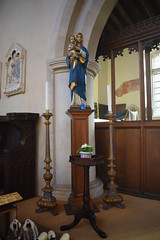 |
|
So, for example, Dowsing
visited three churches during his progress
through Suffolk which today have seven sacrament
fonts, but Dowsing does not mention a single one
of them in his journal; they had all been
plastered over long ago. In fact, Dowsing was not
worried so much about medieval survivals. What
concerned him more was overturning the reforms
put in place by the ritualist Archbishop Laud in
the 1630s. Laud had
tried to restore the sacramental nature of the
Church, primarily by putting the altar back in
the chancel and building it up on raised steps.
Laud had since been beheaded thanks to puritan
popular opinion, but the evidence of his
wickedness still filled the parish churches of
England. The single order that Dowsing gave
during his progress more than any other was that
chancel steps should be levelled.
Much to Dowsing's
frustration, he was delayed at Ufford for two
hours by a dispute between the church wardens
over whether or not to allow him access.The thing
was, he had been here before. Eight months
earlier, as part of a routine visit, he had
destroyed some Catholic images that were in
stained glass, and prayer clauses in brass
inscriptions, but had trusted the churchwardens
to deal with a multitude of other sins, images
that were beyond his reach without a ladder, or
which would be too time-consuming.
|
This was common practice - after
all, the churchwardens of Suffolk were generally equally
as puritan as Dowsing. It was assumed that people in such
a position were supporters of the New Puritan project,
especially in East Anglia. Dowsing rarely revisited
churches. But, for some reason, he felt he had to come
back here to make sure that his orders had been carried
out.
Why was this? In retrospect, we can see that Ufford was
one of less than half a dozen churches where the
churchwardens were uncooperative. Elsewhere, at hundreds
of other churches, the wardens welcomed Dowsing with open
arms. And Dowsing only visited churches in the first
place if it was thought there might be a problem. These
might include churches where the rector had been declared
a 'scandalous minister', although in practice these
theological liberals were often denounced by their own
churchwardens who thus might have been expected to be
supportive of Dowsing's requirements. So, for example
Richard Lovekin, the Rector of Ufford, who had been
turned out of his living the previous year, although he
survived to return when the Church of England was
restored in 1660. But that was in the future. Something
about his January visit told Dowsing that he needed to
come back to Ufford.
Standing in the nave of the
Assumption today, you can still see something that
Dowsing saw, something which he must have seen in
January, but which he doesn't mention until his second
visit, in the entry in his journal for August 21st, which
appears to be written in a passion. This is Ufford's most
famous treasure, the great 15th century font cover.
| It rises, six metres high,
magnificent and stately, into the clerestory,
enormous in its scale and presence. In all
England, only the font cover at Southwold is
taller. The cover is telescopic, and crocketting
and arcading dances around it like waterfalls and
forests. There are tiny niches, filled today with
early 20th Century statuettes. At the top is a
gilt pelican, plucking its breast. Dowsing
describes the font cover as glorious... like
a pope's triple crown... but this is just
anti-Catholic innuendo. The word glorious in
the 17th century meant about the same as the word
'pretentious' means to us now - Dowsing was
scoffing. But that
was no reason for him to be offended by it. The
Anglicans had destroyed all the statues in the
niches a century before, and all that remained
was the pelican at the top, pecking its breast to
feed its chicks. Dowsing would have known that
this was a Catholic image of the Sacrifice of the
Mass, and would have disapproved.
Dowsing mentions that he
had sent one of his deputies to check up on the
work at Ufford in May, but that this deputy had
been denied access to the church. His own two
hour delay, then, would not have put him in the
best of moods.
|
|
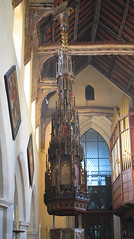 |
What caused the Ufford
churchwardens to keep Dowsing at bay? It would be
romantic to think that they were in some sense protecting
the medieval treasures of their church, but it appears
that this was not the case. It is more likely that it was
laziness or inefficiency on the part of the Ufford men
who had failed to carry out the work required, and now
they were having to face the consequences. Perhaps it was
even an artful Suffolk awkwardness, to get themselves out
of performing an onerous task. The churchwardens tried to
convince Dowsing that they had in fact carried out the
work he had ordered in January, which mostly concerned
dismantling an angel roof and breaking down the medieval
glass. As they stood outside the church while the key was
hunted for, churchwarden Samuel Canham told him that 'I
sent men to rifle the church', and William Brown, who had
been one of the men that Dowsing had charged with the
work back in January, assured him 'I went about to pull
down the church and had carried away part of the church'.
But this was not true. Brown was lying, for the angel
roof survives to this day, although not much of the old
glass does.
Clearly exasperated, Dowsing made a
full list of the furnishings when he eventually gained
access, and the account is one of the longest in the
journal. But he did not order the font cover to be
destroyed. After all, the rest of the cover was harmless
enough, apart from being a waste of good firewood, and
the incompetence of the Ufford churchwardens seems to
have put him off suggesting that it should be reduced to
such. Certainly, there can have been no liturgical reason
for the churchwardens to decide to keep their font cover.
Perhaps they simply knew it to be beautiful, and that
they also knew it had been constructed by ordinary
workmen of their parish two hundred years before, under
the direction of some European master designer.
While the font cover is
extraordinary, and of national importance, it is one of
just several medieval survivals in the nave of the
Assumption. All around it are 15th century benches, with
superbly characterful and imaginative images on their
ends. The best is the bench with St Margaret and St
Catherine on it. This was recently on display at the
Victoria and Albert Museum as part of the Gothic
exhibition. Other bench end figures include a long
haired, haloed woman seated on a throne, which may well
be a representation of the Mother of God Enthroned, and
another which may be the Coronation of the Queen of
Heaven. There is also a praying woman in a butterfly
headdress, once one of a pair, and a man wearing what
appears to be a bowler hat, although I expect it is a
helmet of some kind. His beard is magnificent. There are
also a number of finely carved animals, both mythical and
real.
 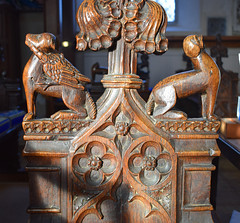 
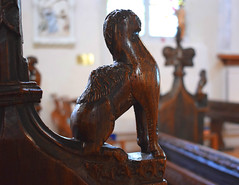 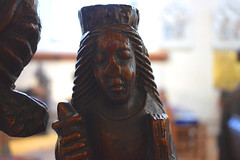 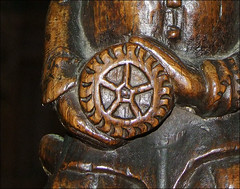 
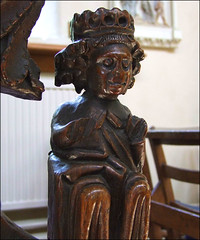 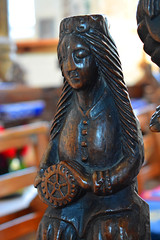 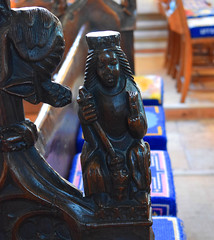 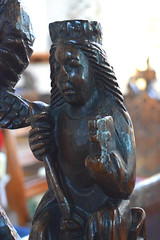 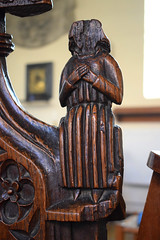
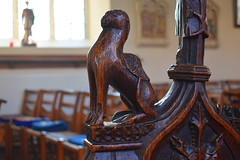  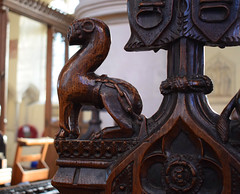 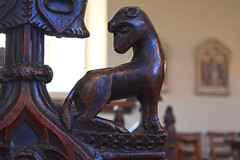
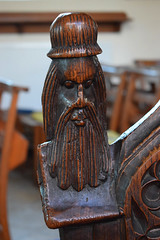 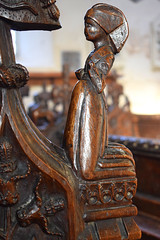 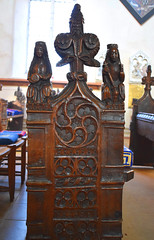 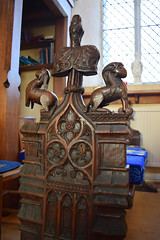 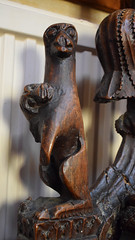
High up in the chancel arch is an
unusual survival, the crocketted rood beam that once
supported the crucifix, flanked by the grieving Mary and
John, with perhaps a tympanum behind depicting the last
judgement. These are now all gone, of course, as is the
rood loft that once stood in front of the beam and
allowed access to it. But below, the dado of the screen
survives, with twelve panels. Figures survive on the
south side. They have not worn well. They are six female
Saints: St Agnes, St Cecilia, St Agatha, St Faith, St
Bridget and, uniquely in England, St Florence. Curiously,
the head of this last has been, in recent years,
surrounded by stars, in imitation of the later Our Lady
of the Immaculate Conception. Presumably this was done in
a fit of Anglo-catholic enthusiasm about a century ago.
The arrangement is similar to the south side of the
screen at Westhall, and it may even be that the artist
was the same. While there is no liturgical reason for
having the female Saints on one side and, presumably,
male Saints on the other, a similar arrangement exists on
several Norfolk screens in the Dereham area.
 |
|
Much of the character of
the church today comes from it embracing, in the
early years of the 20th century,
Anglo-catholicism in full flood. It is true to
say that, the later a parish took on the
tradition, the more militant and intensely
expressed it was, and the more evidence there is
likely to be surviving. As at Great Ryburgh in
Norfolk, patronage here ensured that this work
was carried out to the very highest specification
under the eye of the young Ninian Comper. Comper
is an enthusiast's enthusiast, but I think he is
at his best on a small scale in East Anglia like
here and Ryburgh. His is the extraordinary war
memorial window and reredos in the south aisle
chapel, dedicated to St Leonard. The window depicts Christ carrying
his cross on the via dolorosa, but he is
aided by a soldier in WWI uniform and, behind
him, a sailor. The use of blues is very striking,
as is the grain on the wood of the cross which,
incidentally, can also be seen to the same effect
on Comper's reredos at Ryburgh. The elegant, gilt
reredos here profides a lovely foil to the
tremendous window above it.
|
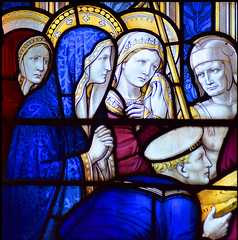 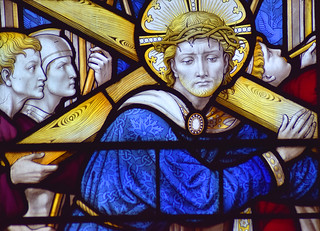 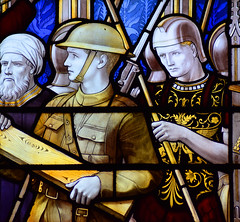
 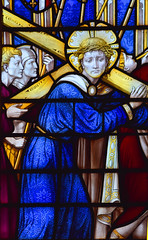 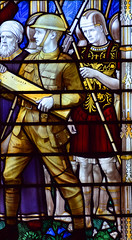 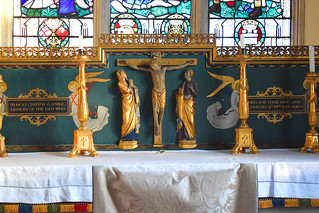
Comper's other major window here is
on the north side of the nave. This is a 1901 depiction
of the Annunciation, although it is the figures above
which are most extraordinary. They are two of the Ancient
Greek sibyls, Erythrea and Cumana, who are associated
with the foretelling of Christ. At the top is a stunning
Holy Trinity in the East Anglian style. There are angels
at the bottom, and all in all this window shows Comper at
the height of his powers.
Stepping into the chancel, there is older glass - or, at
least, what at first sight appears to be. Certainly,
there are some curious roundels which are probably
continental 17th century work, ironically from about the
same time that Dowsing was here. They were probably
acquired by collectors in the 19th century, and installed
here by Victorians. The image of a woman seated among
goats is curious, as though she might represent the
season of spring or be an allegory of fertility, but she
is usually identified as St Agnes. It is a pity this
roundel has been spoiled by dripping cement or plaster.
Another roundel depicts St Sebastian shot with arrows,
and a third St Anthony praying to a cross in the desert.
The two angels in the glass on the
opposite side of the chancel are perhaps more
interesting. They are English, probably early 16th
Century, and represent two of the nine Orders of Angels,
Dominions and Powers. They carry banners written in
English declaring their relationships to earthly kings
(Dominions) and priests and religious (Virtues). They
would have been just two of a set of nine, but as with
the glass opposite it seems likely that they did not come
from this church originally.
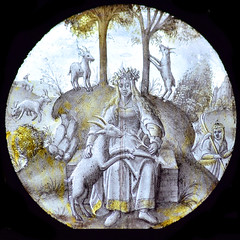 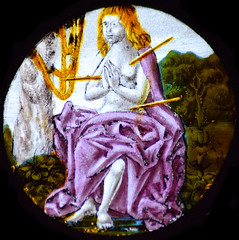 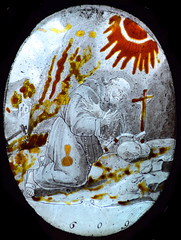
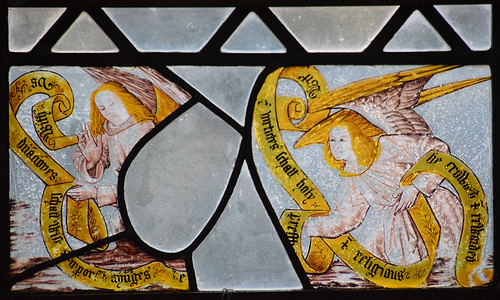
| However, the images in
'medieval' glass in the east window are entirely
modern, though done so well you might not know. A
clue, of course, is that the main figures, St
Mary Salome with the infants St James and St John
on the left, and St Anne with the infant Virgin
on the right, are wholly un-East Anglian in
style. In fact, they are 19th century copies by
Clayton & Bell of images at All Souls
College, Oxford, installed here in the 1970s. I
think that the images of heads below may also be
modern, but the angel below St Anne is 15th
century, and obviously East Anglian, as is St
Stephen to the north. High
above, the ancient roofs with their sacred
monograms are the ones that Dowsing saw, the ones
that the 15th century builders gilded and painted
to be beautiful to the glory of God - and, of
course, to the glory of their patrons. Rich
patronage survived the Reformation, and at the
west end of the south aisle is the massive
memorial to Sir Henry Wood, who died in 1671,
eleven years after the end of the Commonwealth.
It is monumental, the wreathed ox heads a
severely classical motif. Wood, Mortlock tells
us, was Treasurer to the Household of Queen
Henrietta Maria.
There is so much to see in this wonderful church
that, even visiting time and time again, there is
always something new to see, or something old to
see in a new way. It is, above all, a beautiful
space, and, still maintaining a reasonably High
worship tradition, it is is still kept in High
liturgical style. It is at once a beautiful art
object and a hallowed space, an organic
touchstone, precious and powerful.
|
|
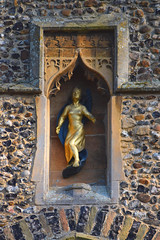 |
Simon Knott, January 2017
Follow these journeys as they happen at Last Of England
Twitter.
|
|
|


